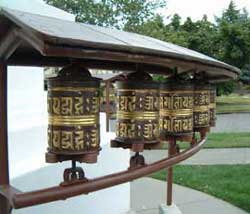|
||||||||||
|
A stupa is a Buddhist shrine, not just a holy site, but a sacred monument and vehicle for teaching and enlightenment. This form of architecture and contemplation is found throughout the world, especially in India, Thailand, Sri Lanka, Cambodia, Nepal, Tibet, China, Japan, Korea and Vietnam. Modern Buddhists have also built these structures in the United States.
 Stupas combine sacred shapes (circles, squares, diamonds) into one larger sacred structure. If viewed from above, you could see that the shapes radiate out symmetrically from a central axis, like a mandala. The overall form includes the five elements, earth, water, air, fire and space. A Buddhist worships by circling inside or around the building or structure, depending on the size. The shape is derived from ancient burial mounds and is symbolic of the tree of enlightenment, the Bodhi tree. Stupas combine sacred shapes (circles, squares, diamonds) into one larger sacred structure. If viewed from above, you could see that the shapes radiate out symmetrically from a central axis, like a mandala. The overall form includes the five elements, earth, water, air, fire and space. A Buddhist worships by circling inside or around the building or structure, depending on the size. The shape is derived from ancient burial mounds and is symbolic of the tree of enlightenment, the Bodhi tree. All stupas are symbolic in Buddhist tradition, but to a person who follows Tibetan Buddhism, the structure is perceived slightly differently. They see the stupa as dharmakaya which means “the body of the doctrine.” The stupa is considered to be a living embodiment of Buddha’s teachings and looking at or meditating on the monument or building itself is able to help the observer move towards nirvana.  On a recent trip to Seattle, I had the chance to stop by the Parinirvana Stupa found at the Sakya Monastery of Tibetan Buddhism. This small stupa is located in the Ballard neighborhood of Seattle. The name “Parinirvana” comes from the word for when Buddha passed from this world. This particular style of stupa is one of the eight forms built by Tibetan Buddhists and is sometimes also called a Dharmaraja Ashoka Stupa. Circles and squares radiate out from a central axis. Around the structure are thirty-two prayer wheels, representing the thirty-two major marks of an enlightened being. All who visit this shrine are invited to partake in the turning of the prayer wheels, called “mani,” that encircle the stupa. On a recent trip to Seattle, I had the chance to stop by the Parinirvana Stupa found at the Sakya Monastery of Tibetan Buddhism. This small stupa is located in the Ballard neighborhood of Seattle. The name “Parinirvana” comes from the word for when Buddha passed from this world. This particular style of stupa is one of the eight forms built by Tibetan Buddhists and is sometimes also called a Dharmaraja Ashoka Stupa. Circles and squares radiate out from a central axis. Around the structure are thirty-two prayer wheels, representing the thirty-two major marks of an enlightened being. All who visit this shrine are invited to partake in the turning of the prayer wheels, called “mani,” that encircle the stupa. Each wheel contains prayers, with these specific wheels each holding scrolls on which the prayer “Om Mani Padme Hum” is written one hundred thousand times each. This mantra invokes the blessing of Chenrezig, the Buddha that is the embodiment of compassion. It is believed that all teachings of the Buddha are contained within that one mantra. Often translated as “Behold! The jewel in the lotus!” this phrase really is untranslatable. Each of the syllables is not a specific word, instead each sound is considered able to purify the attachments that human beings have to the material realm. “Om” purifies bliss and pride. “Ma” purifies jealousy and lust for entertainment. “Ni” purifies passion and desire. “Pad” purifies stupidity and prejudice. “Me” purifies poverty and possessiveness. “Hum” purifies aggression and hatred. Each wheel contains prayers, with these specific wheels each holding scrolls on which the prayer “Om Mani Padme Hum” is written one hundred thousand times each. This mantra invokes the blessing of Chenrezig, the Buddha that is the embodiment of compassion. It is believed that all teachings of the Buddha are contained within that one mantra. Often translated as “Behold! The jewel in the lotus!” this phrase really is untranslatable. Each of the syllables is not a specific word, instead each sound is considered able to purify the attachments that human beings have to the material realm. “Om” purifies bliss and pride. “Ma” purifies jealousy and lust for entertainment. “Ni” purifies passion and desire. “Pad” purifies stupidity and prejudice. “Me” purifies poverty and possessiveness. “Hum” purifies aggression and hatred.People are asked to walk around the stupa clockwise, turning the prayer wheels clockwise by the wooden handles at the bottom of them as they go. By turning each wheel, it is equivalent to saying all the prayers contained inside. One circuit around the stupa releases 320,000 prayers for peace. Visitors are invited to circle the stupa as many times as they wish. I circled the stupa three times, releasing 960,000 prayers into the world. |
||||||||||
